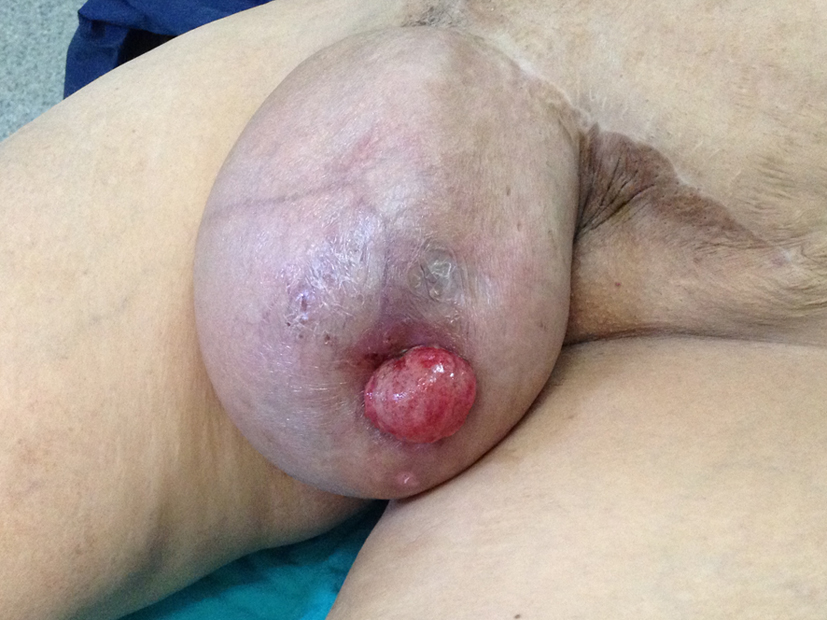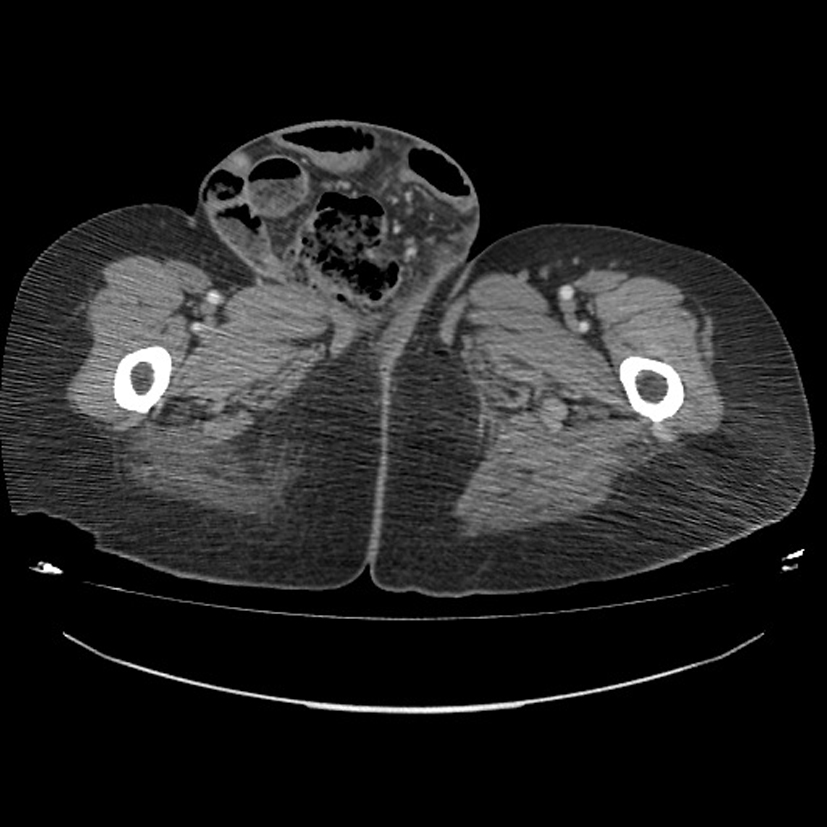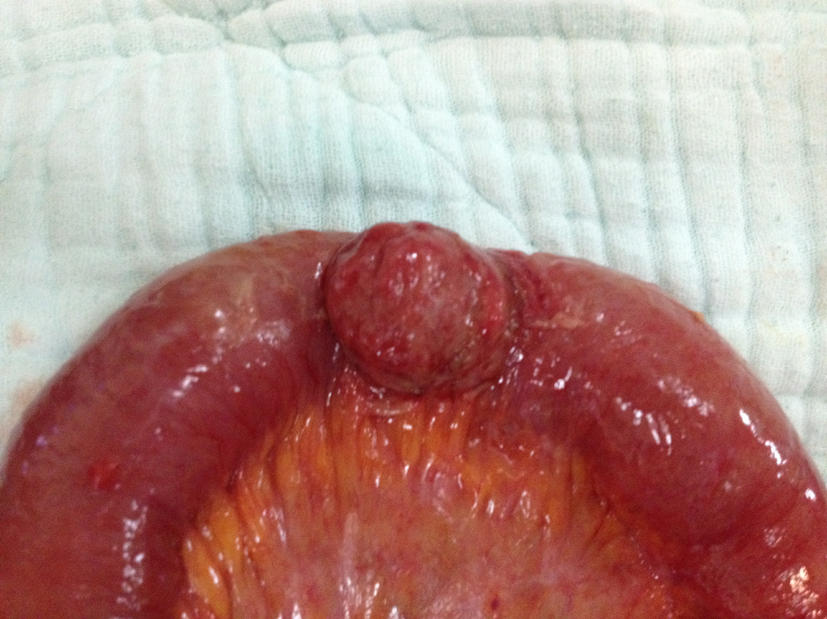| Journal of Medical Cases, ISSN 1923-4155 print, 1923-4163 online, Open Access |
| Article copyright, the authors; Journal compilation copyright, J Med Cases and Elmer Press Inc |
| Journal website http://www.journalmc.org |
Case Report
Volume 4, Number 11, November 2013, pages 729-731
A Successful Repair of Incarcerated and Eviscerated Hernia With Polypropylene Mesh
Seckin Akkucuka, b, Akin Aydogana, Ilhan Paltacia, Aydin Kaplana, Mustafa Ugura
aDepartment of General Surgery, Faculty of Medicine, Mustafa Kemal University, Hatay, Turkey
bCorresponding author: Seckin Akkucuk, Department of General Surgery, Medicine Faculty of Mustafa Kemal University, Hatay, Turkey
Manuscript accepted for publication June 6, 2013
Short title: Incarcerated and Eviscerated Incisional Hernia
doi: https://doi.org/10.4021/jmc1348w
| Abstract | ▴Top |
The aim of this study is to present a case of eviscerated and incarcerated recurrent incisional hernia successfully repaired with polypropylene mesh. A 65-year-old woman with recurrent incarcerated incisional hernia with spontaneous evisceration was admitted to our emergency clinic. She had undergone herniorrhaphy, segmental ileal resection, end-to-end anastomosis, primary abdominal wall repair, and polypropylene mesh repair. No intraoperative or postoperative complication occurred. Even though incisional hernia is frequent, spontaneous rupture and evisceration in these cases are very unusual. The most seen cause of this situation is tense ascites due to chronic liver disease. Eviscerated and incarcerated incisional hernias are contaminated cases, and use of prostethic mesh for hernia repair is still controversial. Washing the bowel with saline before replacing it into the abdomen and application of antibiotics during surgery and for 2-4 days in postoperative period can prevent infectious complications after mesh repair.
Keywords: Incisional hernia; Evisceration; Incarceration; Polypropylene mesh; Hernia repair
| Introduction | ▴Top |
Incisional hernia (IH) is a frequent, worldwide complication. In the USA, approximately 200,000 patients per year undergo surgery for incisional hernias. Older age (>45 years), male sex, obesity, smoking, severe anemia, multiple interventions, and chronic diseases like diabetes mellitus, chronic obstructive pulmonary disease, and coronary heart disease are the patient related risk factors. Also wound healing complications such as seroma, hematoma, and surgical infection are the other risk factors [1, 2].
Even though incisional hernia is frequent, spontaneous rupture and evisceration in these cases are very unusual. The most seen cause of this situation is tense ascites due to chronic liver disease. Evisceration of the abdominal organs requires urgent surgery in terms of hernia repair [3].
Here we present a patient with eviscerated and incarcerated incisional hernia repaired with polypropylene mesh successfully.
| Case Report | ▴Top |
A 65-year-old woman was admitted to our emergency clinic with a large incisional hernia in her right sight of groin and with a short segment of intestine eviscerated through the hernia (Fig. 1). Pfannenstiel incision, huge incarcerated incisional hernia, and eviscerated intestine were recorded during physical examination. She had a medical history including cesarean section 30 years ago and four incisional hernia repairs (two of them were with mesh repair) in subsequent years. The last hernia repair was 20 months ago. Her vital signs and blood tests were normal. Ultrasonography, performed to examine the superficial fascial space, revealed intestinal segments protruded to the right site of groin. Next, lower abdominal computed tomography was performed. It revealed the herniation of intestinal segments and mesenteric lipomatous tissue to the subcutaneous area through the muscular tissue in the abdominal right lower quadrant (Fig. 2).
 Click for large image | Figure 1. A huge recurrent eviscerated incisional hernia in the right groin. |
 Click for large image | Figure 2. Herniation of intestinal segments and mesenteric lipomatous tissue to the subcutaneous area in the right groin (pelvic computed tomography). |
An urgent intervention was decided. Approximately 4 cm of intestine was incarcerated in the doom of the perforated hernia sac and the hernia gap was about 6 cm of diameter. The eviscerated segment of intestine’s (ileum) wall was thinned and there were several serosal defects (Fig. 3). So, segmental resection and end-to-end ileoileal anastomosis were performed. Next the hernia gap was repaired with primary sutures and then a prosthetic mesh repair was added to the procedure. The redundant and unhealthy skin was excised and the wound was closed over subcutaneous hemovac drain. We applied 1,000 mg of cefazolin sodium twice a day for 5 postoperative days. The drain was removed at postoperative 2nd day. After 5 days of follow-ups, the patient was discharged without any complication. The patient was examined 6 months after the intervention and there were no signs of hernia recurrence.
 Click for large image | Figure 3. The eviscerated ileal segment (intraoperative view). |
| Discussion | ▴Top |
Incisional hernias result from a wound healing disorder of a prior abdominal surgery with a rate of 10-15% of all laparotomies. Although most of IHs are asymptomatic, pain, incarceration, strangulation may also be present [2]. Our patient had abdominal pain but no more symptoms.
There are several risk factors of incisional hernia including systemic disorders like chronic obstructive pulmonary disease, diabetes mellitus, malignancies, obesity, nicotine consumption, and surgical complications like infection, seroma, hemotama, and so on. Also recurrent interventions, especially within the same year, are other considerable risk factors [1, 2]. No comorbidity but multiple abdominal operations for the same purpose (hernia repair) and older age (65 years) as risk factors were present in our patient’s medical history.
Spontaneous evisceration of hernias is very uncommon and usually occurs due to tense ascites. The redundant and unhealthy skin may lost its sufficient vascularity due to the tension of the hernia sac and this may cause an ulceration and then spontaneous perforation leading to evisceration in patients with prolonged hernia history [3, 4]. Our patient’s last surgery was 20 months ago and a huge hernia was present nearly since then. The skin was thinned and stretched. After hernia repair, the redundant and unhealthy skin should be removed for both appropriate wound healing and cosmetics.
Eviscerated and incarcerated incisional hernias are contaminated cases, and this may preclude the use of prosthetic mesh for hernia repair. Most surgeons beware of using prosthetic meshes in the setting of incarcerated hernia. Washing the bowel with saline before replacing it into the abdomen and application of antibiotics during surgery and for 2-4 days in postoperative period can prevent infectious complications [1, 4]. The eviscerated segment of ileum was short in our patient; therefore we washed the bowel with saline at the beginning of the operation and used mesh after the primary closure of the hernia gap. There is only one case in literature about successful mesh usage for repairing the eviscerated incisional hernia and here is the second one [5].
Conflict of Interest
There is no conflict of interest in this study.
Grant Support
There is no funding support in this study.
| References | ▴Top |
- Dietz UA, Winkler MS, Hartel RW, Fleischhacker A, Wiegering A, Isbert C, Jurowich C, et al. Importance of recurrence rating, morphology, hernial gap size, and risk factors in ventral and incisional hernia classification. Hernia. 2014;18(1)19-30.
doi - Bell RL, Seymour NE. Abdominal wall, omentum, mesentery, and retroperitoneum. In: Brunucardi FC (ed) Schwartz's Principals of Surgery, 8th edn. New York: McGraw-Hill. 2005;pp1317-1328.
pubmed - Zaz MA, Dass T, Muhee A, Kawoosa U. An unusual case of inguinal hernia with spontaneous evisceration. Hernia. 2011;15(6):705-707.
doi pubmed - Gupta RK, S S, S CA. Spontaneous rupture of incisional hernia: a rare cause of a life-threatening complication. BMJ Case Rep. 2011;2011.
- Beltran MA, Danilova T, Cruces KS. Mesh repair for spontaneous rupture of incisional hernia and evisceration: report of one case. Rev Chil Cir. 2006;58(2):147-150.
This is an open-access article distributed under the terms of the Creative Commons Attribution License, which permits unrestricted use, distribution, and reproduction in any medium, provided the original work is properly cited.
Journal of Medical Cases is published by Elmer Press Inc.


